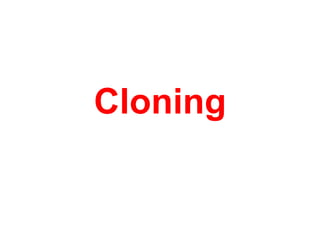Recommended
More Related Content
What's hot
What's hot (20)
MICROPROPAGATION OF MEDICINAL & AROMATIC PLANTS / CLONAL PROPAGATION

MICROPROPAGATION OF MEDICINAL & AROMATIC PLANTS / CLONAL PROPAGATION
plant tissue culture and its applications. Agricultural biotech.

plant tissue culture and its applications. Agricultural biotech.
Role of eliciator in production of plant secondary metabolite

Role of eliciator in production of plant secondary metabolite
Viewers also liked
Viewers also liked (18)
Similar to Cloning
Similar to Cloning (20)
cell cloning- Therapeutic and reproductive cloning

cell cloning- Therapeutic and reproductive cloning
Cloning experiments in amphibians, mammals and human

Cloning experiments in amphibians, mammals and human
Cloning : introduction, types , advantages and disadvantages

Cloning : introduction, types , advantages and disadvantages
BIOLOGY FORM 5 CHAPTER 5 - 5.3 B (Genetics Application)

BIOLOGY FORM 5 CHAPTER 5 - 5.3 B (Genetics Application)
More from Steve Bishop
More from Steve Bishop (20)
Cloning
- 1. Cloning
- 2. Cloning Key terms Clones Tissue culture Embryo transplants Genetic information
- 3. Cloning •Humans can carry out various procedures to create clones of plants and animals. •These new individuals are genetically identical to the parents. •New plants can be produced quickly and cheaply by taking cuttings from older plants. cutting dipped in rooting powder and planted stem cut from parent plant
- 4. Modern cloning techniques include: • Tissue culture • Embryo transplants and • Animal cell cloning
- 5. Tissue culture •This uses small groups of cells from part of a plant to grow new plants.
- 6. Embryo transplants •This involves splitting apart cells from a developing animal embryo before they become specialised. •The identical embryos are then implanted into the wombs of host mothers
- 7. Advantages •This technique could be used to make many copies of cows that have a high milk yield. •It would produce a herd of cows much faster than if the original cow was used for breeding in the normal way. Concerns •People do not want this procedure to be used in humans. •It could be used to provide more embryos for scientific testing.
- 8. Adult cell cloning •The nucleus is removed from an unfertilised egg cell. •This is replaced with the nucleus of an adult cell (eg skin cell). •An electric shock is used to start the cell dividing to form embryo cells. •These embryo cells contain the same genetic information as the adult skin cell. •When the embryo has developed into a ball of cells, it is inserted into the womb of an adult female to continue its development.
- 10. Advantages •This could be used to clone animals with desired characteristics, eg farm animals. •It could possibly be used to save animals from extinction. Concerns •People do not want human babies to be cloned. •If this is used in farming, it produces lots of genetically identical individuals; •If there is a change in the environment, they may all struggle to survive.
